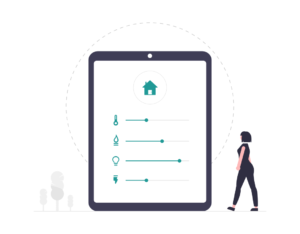Internet of Things (IoT)

The Internet of Things (IoT) is a transformative technology concept that has significantly impacted how we interact with everyday objects and data. IoT involves connecting physical devices to the internet, allowing them to communicate, collect, and share data. In this article, we’ll have a basic understanding of IoT and explores its diverse applications across industries, demonstrating its impact on technology, business, and society.
What is the Internet of Things (IoT)?
The Internet of Things (IoT) refers to the network of interconnected physical devices that are embedded with sensors, software, and other technologies, enabling them to collect and exchange data over the internet. IoT allows devices to interact with each other and with central systems, creating a seamless ecosystem where data flows freely.
Key Characteristics of IoT
- Connectivity: IoT devices are connected to the internet, enabling communication and data exchange.
- Interoperability: IoT involves the integration of diverse devices and systems, allowing them to work together.
- Automation: IoT devices can perform tasks automatically based on data and pre-defined rules.
- Data Collection and Analytics: IoT generates large volumes of data, which can be analyzed to gain insights and inform decision-making.
Components of an IoT System
An IoT system typically comprises several key components that work together to create a connected ecosystem. These components include:
- Devices and Sensors
Devices are the physical objects connected to the IoT network, while sensors are the components that collect data from the environment. Sensors can measure various parameters, such as temperature, humidity, motion, and pressure.
- Connectivity and Communication
IoT devices communicate with each other and with central systems using various communication protocols. Common IoT communication technologies include Wi-Fi, Bluetooth, Zigbee, LoRa, and cellular networks.
- Data Processing and Analytics
Data collected by IoT devices is processed and analyzed to derive insights and inform decisions. This process often involves edge computing (processing data closer to the source) and cloud computing (centralized data processing).
- User Interfaces
User interfaces allow users to interact with IoT systems, often through mobile apps, web dashboards, or voice assistants. These interfaces provide a means to control devices, view data, and set automation rules.
- Security and Privacy
Security is a critical component of IoT, ensuring that data is protected from unauthorized access and that devices are secure from threats. Privacy concerns are also addressed through measures like data encryption and access controls.
If you are reading this, then why not read some more relevant articles given below?
Applications of IoT
IoT has a wide range of applications across various industries, driving innovation and improving efficiency. Here are some common applications of IoT:
1. Smart Homes
IoT has revolutionized home automation, allowing users to control and monitor various aspects of their homes remotely. Smart home applications include:
- Smart Lighting: IoT-enabled lighting systems can be controlled remotely and programmed to operate automatically based on schedules or motion sensors.
- Smart Thermostats: These devices can learn user preferences and adjust temperature settings accordingly, reducing energy consumption.
- Security Systems: IoT-based security systems allow users to monitor their homes through cameras and sensors, receiving alerts for unusual activity.
2. Industrial IoT (IIoT)
Industrial IoT (IIoT) focuses on applying IoT in industrial settings, such as manufacturing, logistics, and energy. IIoT applications include:
- Predictive Maintenance: IoT sensors on industrial equipment can detect early signs of wear and tear, enabling proactive maintenance to prevent breakdowns.
- Supply Chain Optimization: IIoT enables real-time tracking of inventory and shipments, improving supply chain efficiency and reducing delays.
- Industrial Automation: IoT allows for greater automation in manufacturing processes, enhancing productivity and reducing costs.
3. Healthcare and Wearable Devices
IoT has significant applications in healthcare, improving patient monitoring and care. Common IoT applications in healthcare include:
- Wearable Health Devices: Wearable devices like smartwatches and fitness trackers collect health-related data, such as heart rate and activity levels.
- Remote Patient Monitoring: IoT allows healthcare providers to monitor patients remotely, providing real-time health data for better diagnosis and treatment.
- Medication Management: IoT devices can help patients manage their medication schedules, sending reminders and alerts for compliance.
4. Smart Cities
IoT plays a key role in creating smart cities, where technology is used to improve urban infrastructure and services. Smart city applications include:
- Smart Transportation: IoT enables intelligent traffic management, smart parking, and connected public transportation systems.
- Environmental Monitoring: IoT sensors can monitor air quality, noise levels, and other environmental factors to improve city planning and sustainability.
- Public Safety: IoT-based surveillance systems and emergency response technologies enhance public safety and security.
5. Agriculture and Smart Farming
IoT is transforming agriculture by enabling smart farming practices. IoT applications in agriculture include:
- Precision Agriculture: IoT sensors can monitor soil conditions, weather, and crop health, allowing farmers to optimize resource use and increase yields.
- Livestock Monitoring: IoT devices can track the health and location of livestock, improving animal welfare and farm management.
- Automated Irrigation: IoT-based irrigation systems can adjust watering based on soil moisture and weather conditions, reducing water waste.